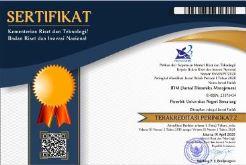Job Embeddedness: a Strategy to Reduce Voluntary Turnover Intention
Abstract
Keywords
Full Text:
PDFReferences
Afsar, B., Shahjehan, A., & Shah, S. I. (2018). Frontline Employees’ High-Performance Work Practices, Trust in Supervisor, Job-Embeddedness and Turnover Intentions in Hospitality Industry. International Journal of Contemporary Hospitality Management, 30(3), 1436-1452.
Akgunduz, Y., & Eryilmaz, G. (2018). Does Turnover Intention Mediate the Effects of Job Insecurity and Co-Worker Support on Social Loafing?. International Journal of Hospitality Management, 68(1), 41-49.
Alessandri, G., Consiglio, C., Luthans, F., Borgogni, L. (2018). Testing a Dynamic Model of the Impact of Psychological Capital on Work Engagement and Job Performance. Career Development International, 23(1), 33-47.
Allen, D. G. (2006). Do Organizational Socialization Tactics Influence Newcomer Embeddedness and Turnover?. Journal of Management, 32(2), 237-56.
Bothma, F. C., & Roodt, G. (2012). Work-Based Identity and Work Engagement as Potential Antecedents of Task Performance and Turnover Intention: Unravelling a Complex Relationship. SA Journal of Industrial Psychology, 38(1), 1-17.
Chan, D., & Schmitt, N. (2002). Situational Judgment and Job Performance. Human Performance, 15(3), 233-254.
Chang, W. J. A., Wang, Y. S., & Huang, T. C. (2013). Work Design-Related Antecedents of Turnover Intention: a Multilevel Approach. Human Resource Management, 52(1), 1-26.
Chirumbolo, A., & Areni, A. (2005). The Influence of Job Insecurity on Job Performance and Absenteeism: the Moderating Effect of Work Attitudes. SA Journal of Industrial Psychology, 31(4), 65-71.
Cho, Y., & Ryu, J. (2009). Organizational Citizenship Behaviors in Relation to Job Embeddedness, Organizational Identification, Job Performance, Voluntary Turnover Intention in Korea. International Business & Economics Research Journal, 8(7), 51-68.
Coetzer, A., Inma, C., Poisat, P., Redmond, J., & Standing, C. (2019). Does Job Embeddedness Predict Turnover Intentions in SMES?. International Journal of Productivity and Performance Management, 68(2), 340-361.
Dechawatanapaisal, D. (2018). The Moderating Effects of Demographic Characteristics and Certain Psychological Factors on the Job Embeddedness-Turnover Relationship among Thai Healthcare Employees. International Journal of Organizational Analysis, 26(1), 43-62.
Dordunu, W., Owusu, G. M. Y., & Simpson, S. N. Y. (2020). Turnover Intentions and Job Performance of Accountants: the Role of Religiosity and Spiritual Intelligence. Journal of Research in Emerging Markets, 2(1), 43-61.
Felps, W., Mitchell, T. R., Lee, T. W., & Harman, W. S. (2009). Turnover Contagion: How Coworkers’ Job Embeddedness and Job Search Behaviors Influence Quitting. Academy of Management Journal, 52(3), 545-561.
Gerhart, B. (1990). Voluntary Turnover and Alternative Job Opportunities. Journal of Applied Psychology, 75(5), 467-476.
Halbesleben, J. R. B., & Wheeler, A. R. (2008). The Relative Roles of Engagement and Embeddedness in Predicting Job Performance and Intention to Leave. Work and Stress, 22(3), 242-256.
Holtom, B. C., & Inderrieden, E. J. (2006). Integrating the Unfolding Model and Job Embeddedness Model to Better Understand Voluntary Turnover. Journal of Managerial Issues, 18(4), 435-452.
Hom, P. W., & Griffeth, R. W. (1991). Structural Equations Modeling Test of a Turnover Theory: Cross-Sectional and Longitudinal Analyses. Journal of Applied Psychology, 76(3), 350-366.
Hui, C., Wong, A., & Tjosvold, D. (2007). Turnover Intention and Performance in China: the Role of Positive Affectivity, Chinese Values, Perceived Organizational Support and Constructive Controversy. Journal of Occupational and Organizational Psychology, 80(4), 725-731.
Karatepe, O. M., & Ngeche, R. N. (2012). Does Job Embeddedness Mediate the Effect of Work Engagement on Job Outcomes? a Study of Hotel Employees in Cameroon. Journal of Hospitality Marketing and Management, 21(4), 440-461.
Lee, T. W., Mitchell, T. R., Sablynski, C. J., Burton, J. P., & Holtom, B. C. (2004). The Effects of Job Embeddedness on Organizational Citizenship, Job Performance, Volitional Absences, and Voluntary Turnover. Academy of Management Journal, 47(5), 711-722.
Mccloy, R. A., Campbell, J. P., & Cudeck, R. (1994). A Confirmatory Test of a Model of Performance Determinants. Journal of Applied Psychology, 79(4), 493-505.
Mitchell, T. R., Holtom, B. C., Lee, T. W., Sablynski, C. J., & Ere, M. (2001). Why People Stay: Using Job Embeddedness to Predict Voluntary Turnover. Academy of Management Journal, 44(6), 1102-1121.
Mitchell, T. R., & Lee, T. W. (2001). The Unfolding Model of Voluntary Turnover and Job Embeddedness: Foundations for a Comprehensive Theory of Attachment. Research in Organizational Behavior, 23(1), 189-246.
Mobley, W. H., Horner, S. O., & Hollingsworth, A. T. (1978). An Evaluation of Precursors of Hospital Employee Turnover. Journal of Applied Psychology, 63(4), 408-414.
Peltokorpi, V. (2013). Job Embeddedness in Japanese Organizations. International Journal of Human Resource Management, 24(8), 1551-1569.
Sekiguchi, T., Burton, J. P., & Sablynski, C. J. (2008). The Role of Job Embeddedness on Employee Performance: the Interactive Effects with Leader-Member Exchange and Organization-Based Self-Esteem. Personnel Psychology, 61(4), 761-792.
Smithson, J., & Lewis, S. (2000). Is Job Insecurity Changing the Psychological Contract?. Personnel Review, 29(6), 680-702.
Staufenbiel, T., & König, C. J. (2010). A Model for the Effects of Job Insecurity on Performance, Turnover Intention, and Absenteeism. Journal of Occupational and Organizational Psychology, 83(1), 101-117.
Tian, A. W., Cordery, J., & Gamble, J. (2016). Staying and Performing: How Human Resource Management Practices Increase Job Embeddedness and Performance. Personnel Review, 45(5), 947-968.
View Counter: Abstract - 1634 and PDF - 1207
Refbacks
- There are currently no refbacks.





